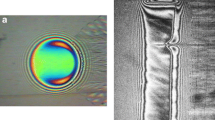Abstract
THE traditional ‘time dependence of static friction’ approach, which is used to explain observed variations in static friction, has limited validity1. The appropriate governing variable is the rate of increase of the tangential force coefficient, θ̇, and not the static contact time as has been suggested previously1. (θ̇ = Ḟ/N where N is the normal load forcing opposing surfaces together and Ḟ is the rate of application of the shearing force.)
Similar content being viewed by others
References
Johannes, V. I., Green, M. A., and Brockley, C. A., Wear, 24, 381–385 (1973).
Smith, H. A., and McGill, R. M., J. phys. Chem. Ithaca, 61, 1025 (1957).
Author information
Authors and Affiliations
Rights and permissions
About this article
Cite this article
GREEN, M., BROCKLEY, C. Viscoelastic effects in boundary lubrication. Nature 251, 306–307 (1974). https://doi.org/10.1038/251306a0
Received:
Issue Date:
DOI: https://doi.org/10.1038/251306a0
- Springer Nature Limited





